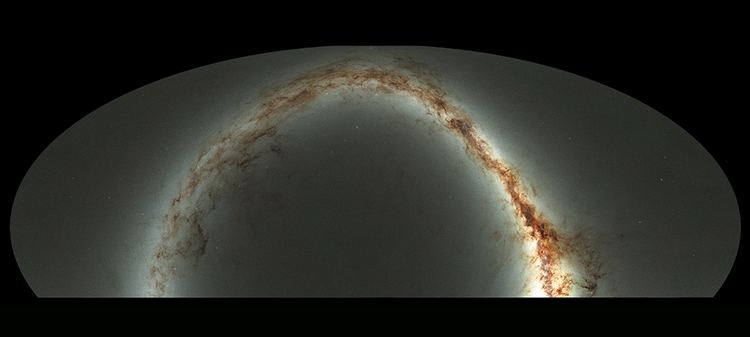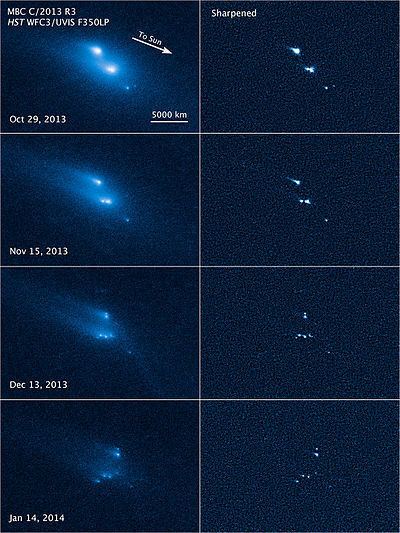 | ||
Largest digital sky survey released by pan starrs
The Panoramic Survey Telescope and Rapid Response System (Pan-STARRS) consists of astronomical cameras, telescopes and a computing facility that is surveying the sky for moving objects on a continual basis, including accurate astrometry and photometry of already detected objects. By detecting differences from previous observations of the same areas of the sky, it is expected to discover a very large number of new asteroids, comets, variable stars and other celestial objects. Its primary mission is to detect near-Earth objects that threaten impact events and is expected to create a database of all objects visible from Hawaii (three-quarters of the entire sky) down to apparent magnitude 24. Pan-STARRS is funded in large part by the United States Air Force through their Research Labs. Pan-STARRS NEO survey searches all the sky north of declination −47.5.
Contents
- Largest digital sky survey released by pan starrs
- Patrick miller student asteroid discovery iasc and pan starrs part 01
- Instruments
- Science
- Military limitations
- Solar System
- Beyond the Solar System
- Discoveries
- References
The first Pan-STARRS telescope (PS1) is located at the summit of Haleakalā on Maui, Hawaii, and went online on December 6, 2008, under the administration of the University of Hawaii. PS1 began full-time science observations on May 13, 2010, and the PS1 Science Mission is underway, with operations funded by the PS1 Science Consortium, PS1SC, a consortium including the Max Planck Society in Germany, National Central University in Taiwan, Edinburgh, Durham and Queen's Belfast Universities in the UK, and Johns Hopkins and Harvard Universities in the United States and the Las Cumbres Observatory Global Telescope Network. Consortium observations for the all sky (as visible from Hawaii) survey were completed in April 2014.
The Pan-STARRS Project is a collaboration between the University of Hawaii Institute for Astronomy, MIT Lincoln Laboratory, Maui High Performance Computing Center and Science Applications International Corporation. Telescope construction is funded by the U.S. Air Force. Having completed PS1, the Pan-STARRS Project is now focusing on building PS2, for which first light was achieved in 2013, with full science operations scheduled for 2014 and then the full array of four telescopes, sometimes called PS4. Completing the array of four telescopes is estimated at a total cost of US$100 million for the entire array.

As of mid-2014, PS2 was in the process of being commissioned. In the wake of substantial funding problems, no clear timeline existed for additional telescopes beyond the second.

Patrick miller student asteroid discovery iasc and pan starrs part 01
Instruments
Pan-STARRS currently (2014) consists of two 1.8 m Ritchey–Chrétien telescopes located at Haleakala in Hawaii.

The initial telescope, PS1, saw first light using a low-resolution camera in June 2006. The telescope has a 3° field of view, which is extremely large for telescopes of this size, and is equipped with the largest digital camera ever built, recording almost 1.4 billion pixels per image. The focal plane has 60 separately mounted close packed CCDs arranged in an 8 × 8 array. The corner positions are not populated, because the optics do not illuminate the corners. Each CCD device, called an Orthogonal Transfer Array (OTA), has 4800 × 4800 pixels, separated into 64 cells, each of 600 × 600 pixels. This gigapixel camera or 'GPC' saw first light on August 22, 2007, imaging the Andromeda Galaxy.
After initial technical difficulties that were later mostly solved, PS1 began full operation on May 13, 2010. Nick Kaiser, principal investigator of the Pan-STARRS project, summed it up saying “PS1 has been taking science-quality data for six months, but now we are doing it dusk-to-dawn every night.” (quote: June 15, 2010). The PS1 images however remain slightly less sharp than initially planned, which significantly affects some scientific uses of the data.
Each image requires about 2 gigabytes of storage and exposure times will be 30 to 60 seconds (good enough to record objects down to apparent magnitude 22), with an additional minute or so used for computer processing. Since images will be taken on a continuous basis, it is expected that 10 Terabytes of data will be acquired by PS4 every night. Comparing against a database of known unvarying objects compiled from earlier observations will yield objects of interest: anything that has changed brightness and/or position for any reason. As of June 30/10 University of Hawaii in Honolulu received an $8.4 million contract modification under the PanSTARRS multi-year program to develop and deploy a telescope data management system for the project. At this time, all funds have been committed (FA9451-06-2-0338; P00008)
The very large field of view of the telescope and the short exposure times enable approximately 6000 square degrees of sky to be imaged every night. The entire sky is 4π steradians, or 4π × (180/π)² ≈ 41,253.0 square degrees, of which about 30,000 square degrees are visible from Hawaii, which means that the entire sky can be imaged in a period of 40 hours (or about 10 hours per night on four days). Given the need to avoid times when the Moon is bright, this means that an area equivalent to the entire sky will be surveyed four times a month, which is entirely unprecedented. By the end of its initial three-year mission in April 2014, PS1 had imaged the sky 12 times in each of 5 filters (g,r,i,z,y).
Science
Systematically surveying the entire sky on a continuous basis is an unprecedented project and is expected to produce a dramatically larger number of discoveries of various types of celestial objects. For instance, the current leading asteroid discovery survey, the Mount Lemmon Survey, reaches an apparent magnitude of 21.5 V and concentrates its searches mostly near the ecliptic; Pan-STARRS will go 3 magnitudes fainter and cover the entire sky visible from Hawaii. The ongoing survey will also complement the efforts to map the infrared sky by the NASA WISE orbital telescope, with the results of one survey complementing and extending the other.
Military limitations
According to Defense Industry Daily significant limitations were put on the PS1 survey to avoid recording sensitive objects. Streak detection software (known as "Magic") was used to censor pixels containing information about satellites in the image. Early versions of this software were immature, leaving a filling factor of 68% of the full field of view (which figure includes gaps between the detectors), but by March 2010 this had improved to 76%, a small reduction from the approximately 80% available. At the end of 2011, the USAF completely eliminated the masking requirement (for all images, past and future). Thus, with the exception of a few non-functioning OTA cells, the entire field of view can be used.
Solar System
In addition to the large number of expected discoveries in the asteroid belt, Pan-STARRS is expected to detect at least 100,000 Jupiter trojans (compared to 2900 known as of end-2008); at least 20,000 Kuiper belt objects (compared to 800 known as of mid-2005); thousands of trojan asteroids of Saturn, Uranus, and Neptune (currently eight Neptune trojans are known, none for Saturn, and one for Uranus); and large numbers of centaurs and comets.
Apart from drastically adding to the number of known Solar System objects, Pan-STARRS will remove or mitigate the observational bias inherent in many current surveys. For instance, among currently known objects there is a bias favoring low orbital inclination, and thus an object such as Makemake escaped detection until recently despite its bright apparent magnitude of 17, which is not much fainter than Pluto. Also, among currently known comets, there is a bias favoring those with short perihelion distances. Reducing the effects of this observational bias will enable a more complete picture of Solar System dynamics. For instance, it is expected that the number of Jupiter trojans larger than 1 km may in fact roughly match the number of asteroid-belt objects, although the currently known population of the latter is several orders of magnitude larger. Pan-STARRS data will elegantly complement the WISE (infrared) survey. WISE infrared images will permit an estimate of size for asteroids and trojan objects tracked over longer periods of time by Pan-STARRS.
Pan-STARRS may detect interstellar objects passing through the Solar System. During the formation of a planetary system, it is thought that a very large number of objects are ejected due to gravitational interactions with planets (as many as 1013 such objects in the case of the Solar System). Objects ejected from planetary systems of other stars might plausibly be throughout the Milky Way and some may pass through the Solar System.
Pan-STARRS may detect collisions involving small asteroids. These are quite rare and none have yet been observed, but with the drastically larger number of asteroids that will be discovered it is expected from statistical considerations that some collision events may be observed.
Beyond the Solar System
It is expected that Pan-STARRS will discover an extremely large number of variable stars, including such stars in other nearby galaxies; in fact, this may lead to the discovery of hitherto unknown dwarf galaxies. In discovering a large number of Cepheid variables and eclipsing binary stars, it will help determine distances to nearby galaxies with greater precision. It is expected to discover a large number of Type Ia supernovae in other galaxies, which are important in studying the effects of dark energy, and also optical afterglows of gamma ray bursts.
Because very young stars (such as T Tauri stars) are usually variable, Pan-STARRS should discover a large number of these and improve our understanding of them. It is also expected that Pan-STARRS may discover a large number of extrasolar planets by observing their transits across their parent stars, as well as gravitational microlensing events.
Pan-STARRS will also measure proper motion and parallax and should thereby discover a large number of brown dwarfs and white dwarfs and other nearby faint objects, and it should be able to conduct a complete census of all stars within 100 parsecs of the Sun. Prior proper motion and parallax surveys often did not detect faint objects such as the recently discovered Teegarden's star, which are too faint for projects such as Hipparcos.
Also, by identifying stars with large parallax but very small proper motion for follow-up radial velocity measurements, Pan-STARRS may even be able to permit the detection of hypothetical Nemesis-type objects if these actually exist.
